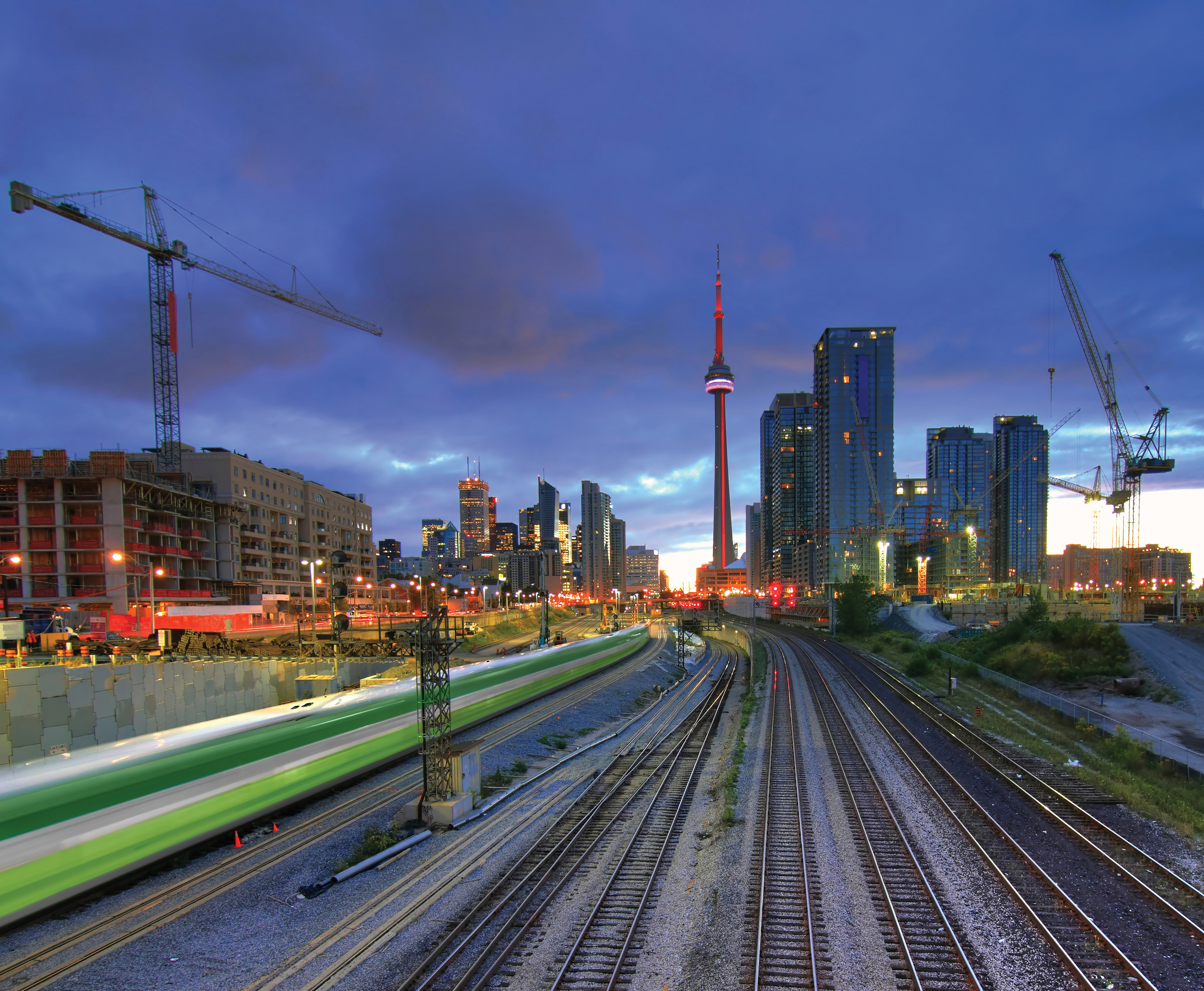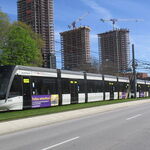crs1026
Superstar
The jolly old guy doesn't seem to care about level boarding, although it would make his night's work much simpler.
- Paul
- Paul
If the Fergus Spur is the "the only realistic chance", maybe it's time to dismiss the idea of passenger rail to Cambridge. The proposed routing to Pinebush has very poor connectivity, and as noted by others, busses would provide a vastly better service at a much lower cost.The Fergus Sub/Spur is the only realistic chance for Cambridge to regain passenger rail service, as the 50 km between Milton and Cambridge along the Galt Sub lack any relevant population centre (almost like the 100 km between the greenbelt and Peterborough along the Havelock Sub), making an extension of the Milton line unviable…
If CN wants to abandon the connection to Guelph, that's fine - the remaining business can interchange with CPKC (actually, the railways will fight this kind of transfer of business, with the support of the current regulatory regime.....and that's something that legislation ought to address.... if CN abandons service, they should abandon the "ownership" of any business opportunity along that territory).
He actually does as his knees are getting bad.The jolly old guy doesn't seem to care about level boarding, although it would make his night's work much simpler.
- Paul
I know this isn’t the takeaway your looking for, but in short, to even say what you have said should be embarrassing for our nation or whomever you choose to attribute blame. On a historical and economic policy level, we should really ask if it is right that Cambridge, a railway town, can only be served by buses.If the Fergus Spur is the "the only realistic chance", maybe it's time to dismiss the idea of passenger rail to Cambridge. The proposed routing to Pinebush has very poor connectivity, and as noted by others, busses would provide a vastly better service at a much lower cost.
The reality is that some places will never have passenger trains, even in Southern Ontario. Cambridge is just plain in the wrong place to make it a worthwhile addition to the GO rail network, as it lacks the size and ridership potential to justify the cost for its own branch.
Metrolinx needs to learn to tell smaller communities like Brantford and Cambridge agitating for rail "no". Busses will always be sufficient for them.
I would take the GO trains up to Cambridge & Brantford but no further than that. But then people in Woodstock and Stratford are going to want GO trains. Where does Metrolinx draw the line? Where does VIA rail step in? Every city can argue they're a "rail city". GO trains are meant to be reginal not intercity. I'm sure there's people on this forum that would argue Peterborough should be served by GO trains.I know this isn’t the takeaway your looking for, but in short, to even say what you have said should be embarrassing for our nation or whomever you choose to attribute blame. On a historical and economic policy level, we should really ask if it is right that Cambridge, a railway town, can only be served by buses.
I see passenger service to Cambridge as a not-so-lofty goal inhibited by the cost, itself a product of policies and failures around the railroads/ways. It is our example that makes me question whether this climate is a social failure; why are well-connected cities like Cambridge penalized for being so? CN/CP operated high quality service when it was their responsibility, yet now Metrolinx only offers high quality service elsewhere.
That is the problem; something is misaligned from then and now, and it is very likely burning money in one way or another. Our path of least resistance for delivering passenger service completely negates prior advantages and assets the RRs themselves showed exist.This should seem wasteful. While GO obviously needed to navigate our policy landscape, we are lucky they were in the right place and time to buy corridors. We cannot replicate that across Ontario; greater change is needed to make our cities whole again.
I think the reason why so many people push for GO trains is because GO is just about the only rail operator around these parts who seems to take expansion seriously. VIA has 4 trains departing daily from Woodstock and 1 from Stratford - I think it's rather generous to call that a service.I would take the GO trains up to Cambridge & Brantford but no further than that. But then people in Woodstock and Stratford are going to want GO trains. Where does Metrolinx draw the line? Where does VIA rail step in? Every city can argue they're a "rail city". GO trains are meant to be reginal not intercity. I'm sure there's people on this forum that would argue Peterborough should be served by GO trains.
I also think Metrolinx should really focus on improving what we currently have, versus constantly extending the lines. I would rather have seen more funding going towards improving Lakeshore East rather then spend that money on extending the line to Bowmanville.
I really don't even know where to begin on this, but suffice to say it grotesquely misses the local context of Fergus.If the Fergus Spur is the "the only realistic chance", maybe it's time to dismiss the idea of passenger rail to Cambridge. The proposed routing to Pinebush has very poor connectivity, and as noted by others, busses would provide a vastly better service at a much lower cost.
The reality is that some places will never have passenger trains, even in Southern Ontario. Cambridge is just plain in the wrong place to make it a worthwhile addition to the GO rail network, as it lacks the size and ridership potential to justify the cost for its own branch.
Metrolinx needs to learn to tell smaller communities like Brantford and Cambridge agitating for rail "no". Busses will always be sufficient for them.
I hope the update to council in the Spring on this project will basically be to shelve it permanently and move on to something that will address the region's transport needs. Wasting resources on such a pie in the sky helps nobody.
I'd be inclined not to bother with Brantford given what an awkward branch of Lakeshore it would create. If there is a place to make a showy demonstration that VIA can be made to work, this is it.I would take the GO trains up to Cambridge & Brantford but no further than that. But then people in Woodstock and Stratford are going to want GO trains. Where does Metrolinx draw the line? Where does VIA rail step in? Every city can argue they're a "rail city". GO trains are meant to be reginal not intercity. I'm sure there's people on this forum that would argue Peterborough should be served by GO trains.
I also think Metrolinx should really focus on improving what we currently have, versus constantly extending the lines. I would rather have seen more funding going towards improving Lakeshore East rather then spend that money on extending the line to Bowmanville.
I'd be inclined not to bother with Brantford given what an awkward branch of Lakeshore it would create. If there is a place to make a showy demonstration that VIA can be made to work, this is it.
Stratford is also a bit of a special case imo; not because GO Trains to London are the ideal service, but in organizational terms putting the entire corridor under Metrolinx makes an awful lot of sense. Clearly the Kitchener - Stratford - London corridor needs more service, and service timed for things other than Toronto bound passengers. Neither VIA nor Metrolinx seem interested, though for rather different reasons. If we can work with VIA great, but if not I don't think a GO run intercity optimized service to London via Kitchener is the worst thing either... Nor for that matter would be Ontario directly operating some intercity service on a brand other than ONR or GO.
I think the reason why so many people push for GO trains is because GO is just about the only rail operator around these parts who seems to take expansion seriously. VIA has 4 trains departing daily from Woodstock and 1 from Stratford - I think it's rather generous to call that a service.
I don't know the politics of the lines serving these towns, but if VIA ran more often, perhaps the calls for GO expansion to there wouldn't exist.
My thinking is that yes, that is absolutely something VIA should do, but given all the factors in play I have real doubts that they can, or would. What tempts me at the moment is tacking a few more Charger sets on to the ONR order with the intent of operating exactly that type of stripped down but definitely intercity service under Metrolinx or ONR authority with some kind branding other than GO (Borrow the UPX design language maybe? OnXpress?); I'd skip any prospect of in seat service, but suggest they at least look at the cost/benefit on a cafe car option.GO Transit offering Intercity rail service? There's something to consider. I think VIA rail does have a desire to expand and improve frequency, but their often hamstrung by so many other factors. Like the state of their equipment/ rolling stock and their extremely high labour costs. VIA's high labour costs come from the fact that most of their trains offer full service. Is it profitable for VIA to run more frequent trains in & out of London and pay higher wages to staff members who simply hand out drinks and snacks? Maybe VIA should offer trains that provide intercity service that don't offer "full service". Something similar to GO trains with only two conductors and one "customer care" staff member for the entire train.
I would agree that that Mx should focus on improving service to where they already serve/own track. But we must wonder if we’re going about rail operations right- I think buses are a piece of clear tape on a policy watermelon with 100 elastic bands on it.I would take the GO trains up to Cambridge & Brantford but no further than that. But then people in Woodstock and Stratford are going to want GO trains. Where does Metrolinx draw the line? Where does VIA rail step in? Every city can argue they're a "rail city". GO trains are meant to be reginal not intercity. I'm sure there's people on this forum that would argue Peterborough should be served by GO trains.
I also think Metrolinx should really focus on improving what we currently have, versus constantly extending the lines. I would rather have seen more funding going towards improving Lakeshore East rather then spend that money on extending the line to Bowmanville.
I think there's a strong case for some kind of intermediate type of service between GO's regional trains and Via's intercity trains, largely due to the service and operating cost issues with Via's current operating model and the limited average speed and extent of GO's services. I wouldn't go so far as to call it Intercity rail, it's more like Regional-Express (between Regional and Intercity).GO Transit offering Intercity rail service? There's something to consider. I think VIA rail does have a desire to expand and improve frequency, but their often hamstrung by so many other factors. Like the state of their equipment/ rolling stock and their extremely high labour costs. VIA's high labour costs come from the fact that most of their trains offer full service. Is it profitable for VIA to run more frequent trains in & out of London and pay higher wages to staff members who simply hand out drinks and snacks? Maybe VIA should offer trains that provide intercity service that don't offer "full service". Something similar to GO trains with only two conductors and one "customer care" staff member for the entire train.
Again, I don't really see what this does that a dedicated bus lane running from Hespeler to Guelph couldn't do.I really don't even know where to begin on this, but suffice to say it grotesquely misses the local context of Fergus.
Pinebush really is quite well positioned for where Cambridge's growth actually is, and integrates well enough with Ion that my actual position is that all efforts should be made to get authorization to operate down Hespeler as a Tram Train. In urbanist terms Fergus also brings rail directly to Hespeler and locks in a higher order transit service on Hwy 24 which is all but certain to urbanize in my view (frankly I'd guess sooner than later; at most the line might be held until Cambridge's developable land around Fountain street is largely built out).
Even taking the Stage 2 study at face value, ridership modeling was on the order of 600,000 low end to 1.8 million high end. These aren't spectacular numbers, but are very far from bad for an American system. A lot more money than it would take to get a good DMU service on Fergus has been spent on the likes of eBART, TexRail and SMART. These aren't GO numbers, but Dillion & Hatch were clearly more attracted to the DMU option than through running bi-levels, and my inclination is that while some Metrolinx support would be nice this should first and foremost be a Region of Waterloo project.
But the January schedules show no time differences.
I am not sure from where else they are getting 10 min off.
According the GO Transit schedule, beginning with the 6 a.m. train out of the Milton GO station, trips that were taking 74 minutes will be down to 64 minutes.
 www.inhalton.com
www.inhalton.com

your timing is bad.
a couple of weeks ago, there was a construction work in Union (electrification or something like that) which delay our arrival by 10 mins.
now there's train work by CP in other part of the track so the train has to run slower (about 10 mins more).
they've revised the schedule to reflect the 10 mins delay now.
What sort of maintenance work was taking place that was causing the trains to slow down?Trip from Milton GO to Toronto will be quicker in new year | INhalton
Beginning Jan. 6, Milton commuters who take the GO Train to Toronto will find the ride a little bit quicker. Metrolinx, the company the runs GO services, announced that the completion of some recent maintenance work will enable trains to run at regular speeds and shave 10 minutes off many trips...www.inhalton.com
So, the 10 min delay is not reflected in the PDF tables. The current PDF tables show the trip taking 64 minutes. But, the 74 minutes trip time is reflected in the timetable (non-pdf)

View attachment 530204
Some Reddit threads from the past couple months.




